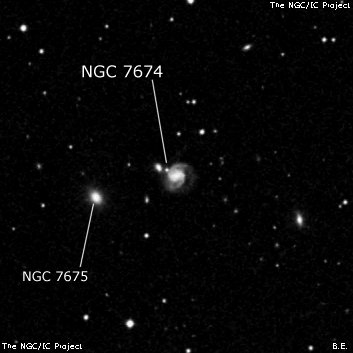
John Herschel discovered NGC 7674 = h2243, along with NGC 7675, on 16 Aug 1830 and reported "F; R; gbM; 30". The p of 2 [with NGC 7675]." Samuel Hunter observed the pair as an assistant at Birr Castle on 30 Sep 1862 and described "Two neb p and f; preceding one [NGC 7674] is double, north-south, north component may only be a * enveloped in nebulosity". The "north component" is MCG +01-59-081 = HCG 96C and if Hunter was more certain, this object would likely have received a NGC designation. The MCG misidentifies MCG +01-59-081 as NGC 7674 and NGC 7674 itself is mislabeled as NGC 7675.
400/500mm - 17.5" (11/28/97): fairly faint, small, roundish, 0.6' diameter, increases to a very small brighter core and a stellar nucleus. Forms a very close pair with MCG +01-59-081 = HCG 96C close off the NE side. Brightest of three visible in the group. CGCG 406-113 is also in the field 8.5' due north.
17.5" (7/16/93): brightest in HCG 96. Fairly faint, fairly small, slightly elongated, bright core, substellar nucleus. A companion (HCG 96c) is just visible at the northeast edge of the halo <1.0' from the center. A possible threshold star mag 16-16.5 is also superimposed at the northeast edge. NGC 7675 lies 2.5' ESE.
17.5" (11/1/86): moderately bright, slightly elongated WNW-ESE, weak concentration. Forms a pair with NGC 7675 2.5' ESE. Seeing poor.
600/800mm - 24" (12/28/13): at 375x appeared fairly bright, fairly small, round, 0.8' diameter, sharply concentrated with a small, very bright core. Brightest in the HCG 96 quartet with CGCG 406-113 = HCG 96C just off the NE edge [33" from center]. HCG 96D (faintest member) lies 1.1' SE and NGC 7675 = HCG 96B is 2.3' ESE.
HCG 96B: moderately bright, fairly small, elongated 4:3 or 5:4 SSW-NNE, 0.6'x0.45', well concentrated with a small, very bright core.
HCG 96C: fairly faint, very small, round, 15" diameter
HCG 96D: extremely faint and small, round, 6" diameter, only pops with averted (at same position) but cannot hold for an extended period.
900/1200mm - 48" (10/30/16): at 610x; very bright, moderately large, round, 0.9' diameter, sharply concentrated with an intensely bright core that increases to a blazing stellar nucleus! The halo has an irregular surface brightness with a strong hint of spiral structure, though no clearly defined arms. A faint star (mag ~16.5) is at the northeast edge and NGC 7674A = HCG 96C is just beyond this star. The contact companion is moderately bright, small, roundish, ~18" diameter, slightly brighter stellar nucleus. NGC 7675 = HCG 96B, the second brightest in the HCG 96 quartet, is 2.3' WSW.
HCG 96D, 1.1' SE and the faintest in the quartet, appeared fairly faint, fairly small, elongated 2:1 or 5:2 N-S, low nearly even surface brightness, ~15"x6". Just outside the field and not catalogued by Hickson are LEDA 214960, 3.8' SW of NGC 7674 and LEDA 1353595, 3.9' E of NGC 7674. The first galaxy appeared fairly faint to moderately bright, elongated 2:1 or 5:2 SSW-NNE, 20"x8", well concentrated with a bright core. LEDA 1353595 was very faint (V = 16.9), small, irregularly round, 10" diameter, very low surface brightness.
Notes by Steve Gottlieb